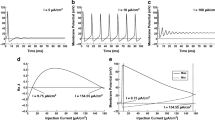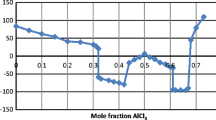Summary
Two local anesthetics — xilocain and trimecain (diethylamino-2,4,6-trimethylacetanilide hydrochloride) —employed clinically were tested on mice for their anticonvulsive actions, by applying the maximum electric shock seizure test (MES) and by the corasole induced convulsions test (metrasole test). Their side-effects (neurological toxicity) were studied by the “rotating bar” technique. Both drugs failed to prevent clonic convulsions after administration of 100 mg/kg corasole. Conversely, they abolished the hindlimb tonic extensor phase of the maximum electrical and corasole shock seizures. The ED50 was determined for both drugs, and their relative activity calculated by the Litchfield and Wilcoxon method (1949). Trimecain proved to be only half as potent as xilocain. It is suggested that both drugs have a common anticonvulsant action.
Similar content being viewed by others
Literature Cited
I. E. Kovalev, Farmakol. i toksikol., No. 5 (1960), p. 385.
I. E. Kovalev, “A comparative study of the resorptive influence of mesocain (trimecain) and xilocain.” Author's abstract candidate's dissertation (Moscow, 1961).
N. T. Pryanishnikova, Farmakol. i toksikol., No. 6 (1957), p. 27.
N. T. Pryanishnikova, Farmakol. i toksikol., No. 2 (1959), p. 138.
C. G. Bernhard and E. Bohrn, Acta physiol. scand., Vol. 31 (1954), p. 104.
C. G. Bernhard and E. Bohm, Experientia (Basel), Vol. 10 (1954), p. 474.
C. G. Bernhard and E. Bohm, Brit. J. Pharmacol., Vol. 10 (1955), p. 288.
C. G. Bernhard, E. Bohm, and S. Höjeberg, Arch. Neurol. Psychiat., Vol. 74 (1955), p. 208.
C. G. Bernhard, E. Bohm, and T. Wiesel, Arch. int. Pharmacodyn., Vol. 108 (1956), p. 392.
C. A. Berry, J. H. Sanner, and H. H. Keasling, J. Pharmacol. exp. Ther., Vol. 133 (1961), p. 357.
E. Bohn, S. Flodmark, and I. Petersen, Arch. Neurol. Psychiat., Vol. 81 (1959), p. 550.
N. W. Dunham and T. S. Miya, J. Am. pharm. Ass. sci. Ed., Vol. 46 (1957), p. 208.
E. H. Jenney and C. C. Pfeiffer, Ann. N. Y. Acad. Sci., Vol. 64, Art. 4 (1956), p. 679.
J. T. Litchfield and F. Wilcoxon, J. Pharmacol. exp. Ther., Vol. 96 (1949), p. 99.
K. Tanaka and V. Kawasaki, Jap. J. Pharmacol., Vol. 6 (1957), p. 115.
Author information
Authors and Affiliations
Rights and permissions
About this article
Cite this article
Raevskii, K.S. Anticonvulsant actions of trimecain and xilocain. Bull Exp Biol Med 54, 1358–1361 (1964). https://doi.org/10.1007/BF00832802
Received:
Issue Date:
DOI: https://doi.org/10.1007/BF00832802




